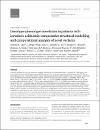Genotype-phenotype correlation in patients with isovaleric acidaemia: comparative structural modelling and computational analysis of novel variants.

View/
Date
2017-08-01Author
Zaki, Osama KPriya Doss C, George
Ali, Salsabil A
Murad, Ghadeer G
Elashi, Shaima A
Ebnou, Maryam S A
Kumar D, Thirumal
Khalifa, Ola
Gamal, Radwa
El Abd, Heba S A
Nasr, Bilal N
Zayed, Hatem
...show more authors ...show less authors
Metadata
Show full item recordAbstract
Isovaleric acidaemia (IVA) is an autosomal recessive inborn error of leucine metabolism. It is caused by a deficiency in the mitochondrial isovaleryl-CoA dehydrogenase (IVD) enzyme. In this study, we investigated eight patients with IVA. The patients' diagnoses were confirmed by urinary organic acid analysis and the blood C5-Carnitine value. A molecular genetic analysis of the IVD gene revealed nine different variants: five were missense variants (c.1193G > A; p. R398Q, c.1207T > A; p. Y403N, c.872C > T; p. A291V, c.749G > C; p. G250A, c.1136T > C; p.I379T), one was a frameshift variant (c.ins386 T; p. Y129fs), one was a splicing variant (c.465 + 2T > C), one was a polymorphism (c.732C > T; p. D244D), and one was an intronic benign variant (c.287 + 14T > C). Interestingly, all variants were in homozygous form, and four variants were novel (p. Y403N, p. Y129fs, p. A291V, p. G250A) and absent from 200 normal chromosomes. We performed protein modelling and dynamics analyses, pathogenicity and stability analyses, and a physiochemical properties analysis of the five missense variants (p.Y403N, R398Q, p.A291V, p.G250A, and p.I379T). Variants p.I379T and p.R398Q were found to be the most deleterious and destabilizing compared to variants p.A291V and p.Y403N. However, the four variants were predicted to be severe by the protein dynamic and in silico analysis, which was consistent with the patients' clinical phenotypes. The p.G250A variant was computationally predicted as mild, which was consistent with the severity of the clinical phenotype. This study reveals a potentially meaningful genotype-phenotype correlation for our patient cohort and highlights the development and use of this computational analysis for future assessments of genetic variants in the clinic.
Collections
- Biomedical Sciences [845 items ]
Related items
Showing items related by title, author, creator and subject.
-
Crosstalk between Microglia and Neurons in Neurotrauma: An Overview of the Underlying Mechanisms.
Haidar, Muhammad Ali; Ibeh, Stanley; Shakkour, Zaynab; Reslan, Mohammad Amine; Nwaiwu, Judith; Moqidem, Yomna Adel; Sader, Georgio; Nickles, Rachel G; Babale, Ismail; Jaffa, Aneese A; Salama, Mohamed; Shaito, Abdullah; Kobeissy, Firas... more authors ... less authors ( Bentham Science Publishers , 2022 , Article Review)Microglia are the resident immune cells of the brain and play a crucial role in housekeeping and maintaining homeostasis of the brain microenvironment. Upon injury or disease, microglial cells become activated, at least ... -
Mechanisms underlying the effects of caloric restriction on hypertension
Ahmad A., Al Attar; Fahed, Gracia I.; Hoballah, Malak M.; Pedersen, Shona; El-Yazbi, Ahmed F.; Nasser, Suzanne A.; Bitto, Alessandra; Orekhov, Alexander N.; Eid, Ali H.... more authors ... less authors ( Elsevier , 2022 , Article)Hypertension is a major risk factor for cardiovascular disease (CVD) as well as a major contributor to all-cause mortality and disability worldwide. The pathophysiology of hypertension is highly attributed to a dysfunctional ... -
Transforming growth factor-β1 inhibits interleukin-1β-induced expression of inflammatory genes and Cathepsin S activity in human vascular smooth muscle cells
Dhaouadi, Nedra; Nehme, Ali; Faour, Wissam H.; Feugier, Patrick; Cerutti, Catherine; Kacem, Kamel; Eid, Ali H.; Li, Jacques-Yuan; Zibara, Kazem... more authors ... less authors ( John Wiley and Sons Inc , 2021 , Article)Objective and design This study investigated the opposite mechanisms by which IL-1β and TGF-β1 modulated the inflammatory and migratory phenotypes in cultured human intimal vascular smooth muscle cells vSMCs. Materials ...


